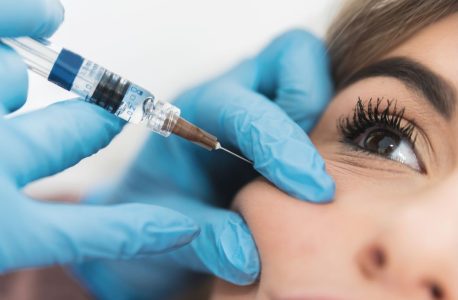A breast lift or mastopexy is a surgery that allows the woman’s chest to be lifted, in cases where it has a sagging appearance.
“Sagging breasts” (breast ptosis) or those with a tubular shape (tuberous breast) can create discomfort in women, damaging their self-esteem, which is why many end up looking for permanent solutions for this condition.
What is breast ptosis?
Breast ptosis, also known as drooping or sagging breasts, is a condition in which women’s breasts lose firmness and elasticity, leading to a lower, less projected position on the chest.
Breast ptosis is more common as a woman ages, experiences significant weight loss, or after pregnancy/breastfeeding, but it can also be a genetic condition.
Breast ptosis stages
The severity of breast ptosis can vary from mild to severe, being classified into stages, generally according to the position of the nipple in relation to the breast crease.
There are several types of classifications for the stages of ptosis, but one of the most common is the Regnault classification, which divides breast ptosis into three main stages:
Stage I (Low)
At this stage, the breast is only slightly drooping:
- The nipple is at or slightly below the inframammary fold (the natural fold under the breast).
- Most of the breast tissue is still above the breast crease.
Stage II (Moderate)
In stage II ptosis, breast drooping is more pronounced:
- The nipple is below the inframammary fold, at a greater distance than in stage I.
- The breast tissue begins to shift downward more significantly, but still maintains some volume above the crease.
Stage III (Severe)
This is the most aggravated state of breast ptosis:
- The nipple is located far below the inframammary fold, usually pointing downwards.
- Most of the breast tissue is found below the breast crease, resulting in a significant droop and loss of breast projection.
What is a tuberous breast?
Tuberous breast, also known as tubular breast, is a congenital breast condition that affects the shape and development of the breasts. It is characterized by a conical shape, with a narrow base, reduced projection and dilated areolas.
Tuberous breast is usually seen after breast development during puberty.
Both breast ptosis and tuberous breasts can be corrected using plastic surgery, more specifically through a breast lift (or mastopexy).
What exactly is the breast lift?
Breast lifting is the surgery that allows the correction of breast ptosis (drooping breast) or tuberous breast (tubular shaped breast and associated ptosis) and consists of removing excess skin and lifting it. This technique can be combined with the placement of an implant (mastopexy with implants). There are cases of tuberous breasts that only require breast augmentation without associated mastopexy.
In this surgery, if necessary, it is also possible to reduce the size of the areola.
Look at some results in our LookBook Mastopexy Before and After.
How is the breast lift performed?
Correcting drooping breasts consists of elevating the areola and nipple, giving shape and volume to the breast.
In this intervention, if the breast volume is not excessive, it is not necessary to eliminate it, just the excess skin is eliminated.
During breast lift surgery, a smaller implant may be placed to support the breast and fill the cleavage. Upon assessment by the surgeon, as a rule, breast implants (prostheses) are only placed when the patient does not have sufficient breast volume for a good cosmetic result.
The surgery normally lasts 2-3 hours.
How is the scar from a breast lift ?
There are three main mastopexy techniques, which leave different types of scars:
Periareolar mastopexy
Incision is made around the areola.
Vertical mastopexy
Technique is used when the sagging of the breasts is more pronounced. The incision is made around the areola and vertically, going down to the breast fold.
Inverted ‘T’ mastopexy
This technique adds an incision at the level of the inframammary fold.
Like any surgical procedure, mastopexy cannot be performed without leaving scars. Their size and visibility depend entirely on the amount of skin removal and technique used. Scars generally become less visible from the 6th month after surgery.
What kind of anaesthesia is used?
Breast lifting is performed under general anesthesia, on an inpatient basis (1 night).
Post op care
Immediately after surgery, a model bra is placed and must be worn for approximately 8 weeks.
About 5 days after the operation, lymphatic drainage massage can begin.
Recovery varies from person to person, but generally involves rest and the possibility of experiencing some temporary discomfort and swelling.
Returning to work depends on the professional activity. In jobs of little physical effort, it can normally start on the 7th day. However, if you have to exercise efforts that require large physical movements, it is advisable to wait 1 month. Physical exercise of the upper limbs only after 6-8 weeks.
This is for reference only, as your plastic surgeon will provide specific instructions on post-operative care, including when you can resume normal activities.
Breast lift price
We are not authorized to publicly disclose the prices of surgical procedures. This information can be communicated directly to patients during a medical appointment, but cannot be published on websites. Schedule a consultation to find out the cost of a breast lift.
What other breast surgeries are there?
In addition to breast lifting, there are other surgeries performed at Living Clinic with the aim of changing the appearance of the breasts, which include:
Breast augmentation
Breast augmentation is a plastic surgery that aims to increase the size and improve the shape of a woman’s breasts. This is usually achieved through the insertion of breast implants or the combination of breast implants and the patient’s own fat.
Breast reduction
Reduction mammoplasty (or breast reduction) is a plastic surgery that involves removing excess breast tissue, fat and skin from the breasts. It is performed to reduce the size and weight of the breasts, relieving symptoms such as back pain and improving the proportion of the breasts in relation to the body.
Gynecomastia
Gynecomastia is a male plastic surgery that involves the removal of excess breast tissue in the male chest area (“enlarged breast”). In some men, abnormal growth of the mammary glands can cause the appearance of feminine breasts, considerably affecting self-esteem.
Schedule your appointment
Whether you have already made a decision or are still in the research phase, schedule a consultation to clarify all your doubts and hear the plastic surgeon’s opinion on your particular case.
Plastic surgeon

Dr. Francisco Martins de Carvalho is a specialist in Plastic, Reconstructive and Aesthetic Surgery. He completed his degree in Medicine at the School of Medicine of the University of Oporto and the Internship in Specific Training in Plastic, Reconstructive and Aesthetic Surgery took place at Hospital de São José (Lisbon) and Hospital de São João (Oporto).
Currently, he is also plastic surgeon at the Hospital de São João – Oporto, and a Invited Lecturer at the School of Medicine of the University of Oporto.
In the field of cosmetic surgery, he has a special interest in cosmetic surgery of the face, cosmetic surgery of the breast, body contouring surgery and vaginal cosmetic surgery.
Schedule an appointment
- Do you want to know more information about a treatment?
- Do you want to know more about Living Clinic?
- Do you want our team’s opinion?
- Do you want to make an appointment?






